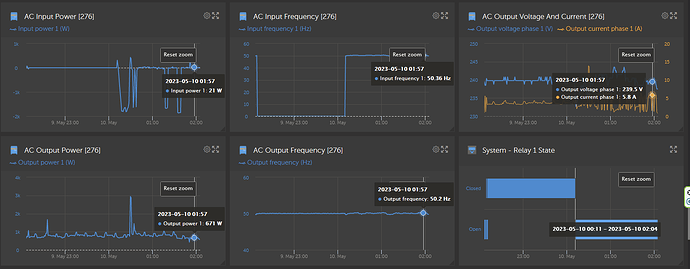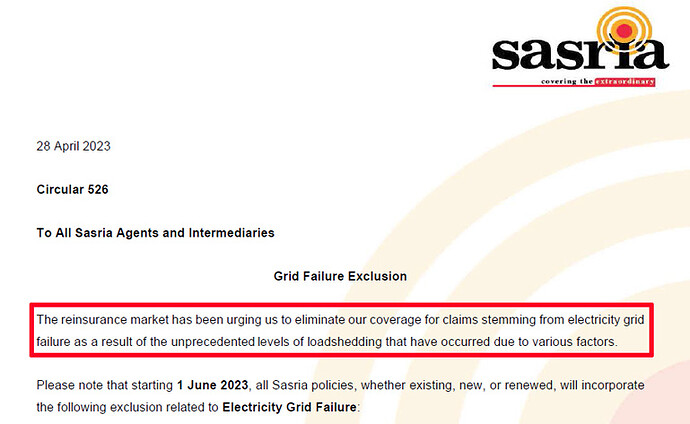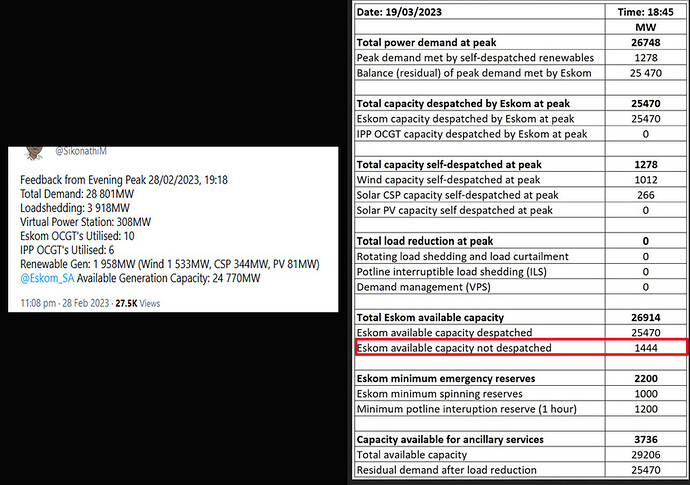Can you explain this, as if I was 5?
As the demand (load) on the grid increases and start exceeding the generating capacity, the generators start to slow down from their 1500 Rpm. 1500 Rpm = 50Hz. The more the demand exceeds capacity, the slower the generators, ie lower Hz.
Groetnis
Let me give you a practical example. This is a small-scale example of what a total blackout will look like, more or less (US video, so 60Hz). Around 1:36 there is a bit of drama (large load, drop in frequency), but the real drama starts around 2:20.
If you drop some of your loads before the frequency drops out too much, the generators pick back up and you’re golden.
You must always have a reserve margin, and this is generally supposed to be around 15%. There is some concern that Eskom is running at about a third of that.
That’s why some of us are watching the grid frequency. The dipping itself isn’t too problematic, it is almost expected around the 2-hour marks where we’re swapping seats in this game of musical (electric?) chairs. But together with a low reserve margin, frequent drops in the grid frequency is an indication that 1) we likely are running at way too low reserve margins, and 2) things are getting worse.
Edit: Now further to this, when you have multiple generators that are synchronised, they are also programmed to protect themselves. They trip if the frequency drops too low. The idea is that you then don’t have to do a complete black start. The turbines are still spinning, in the space of a few days you can resynchronise and get that unit back online.
But in a real grid collapse situation, what happens is that one unit drops out, leaving the rest to cover the load, leading to more dropping out, so you get a domino effect until all stations are either shut down (Koeberg will drop the rods no doubt), or are unsynced to the grid.
At that point, you have to do a black start, which may well require actually turning everything off and back on again.
If we’re lucky, a portion of the grid can suitably island itself so that the entire thing doesn’t go down. Then the damage could be limited to merely one province being down for a few days.
Edit 2: And this is what the reports about Koeberg meant when they said “the reactor remained critical and was resynchronised”. What it means is that while it was disconnected from the grid, they reactor kept making steam and they could resync it to the grid without having to start from zero.
This is probably where the automatic Under Frequency Load Shedding (UFLS) relays will come into play. Apparently there are around 379 of these at mostly municipal and Eskom substations that trip load circuit breakers when there is a sudden drop in grid frequency past certain points as indicated in @Sarel.Wagner’s post. The obvious weakest link here is probably some municipal infrastructure that are not maintained that lead to cascading of trips.
maybe to compensate for cold load pickup (like speeding up on a bicycle when seeing a hill approaching) that should be worse with especially the 4 hour slots of higher stages?
For instance, referring to the impact of geyser loads NRS 048-9 states:
Analysis has shown complete loss of diversity of geyser load is less than a 2 hour period. The cold load pick up on urban networks after 2 hour load shedding can be as high as 180% of the normal value.
Exactly. That’s what I was thinking too. That is why the average is above 50Hz (and why all my clocks are fast).
And I think this is the bits you need to be NRS048 compliant. Probably with redundancy, and proper testing and maintenance too. Which is why Cape Town can run their own show (that, and the fact that Hydro is more dispatchable), but Frankfort cannot. A bit like our houses need anti-islanding to protect the grid from us, parts of the grid needs trip points to protect the larger grid.
I wish I could find a video for this. I recently worked with a generator control module known as the ComAp. These things are amazing. They can do warmup, cooldown, mains monitoring, check fuel levels and oil pressure, engine temperature, etc etc. They control a separate Generator Contactor, which is only pulled in when everything is in order. With something like this, the load will be dropped if the frequency drops out of range.
With some of the higher end controllers, you can even synchronise generators. And once you’re doing that, you’re doing something very similar to what our grid operators do. Multiple synced generators, and you want to avoid overloading them.
And there goes SASRIA to … no cover when Eskom goes down.
You see, here is the thing. These guys are managing their risks, risk accounting. They look at the future probabilities etc. etc… They foresee a very real time where this has a better than not chance of happening. Be prepared is what they are really saying.
VoorbereideGroetnis
Jup.
Always watch insurers … their actuarial risk assessment is top-notch.
The Business Interruption Cover during Covid taught them a new lesson: Don’t assume the court will see the cover the way it was intended for.
And SASRIA, those KZN claims resulting in huge increases in premiums, also learned that lesson.
But that makes it contradictory to “their actuarial risk assessment is top-notch”?
Some things are just not foreseeable … next generation won’t make that mistake again i.e. cover as not intended for AXY, due to the wording, the second sheer incompetence.
I sort of understand the exclusions.
Simple example: I take out insurance on the structure of my house. Big flood happens (once in a thousand years thing), wipes out the entire town. Insurer is wiped out, re-insurer is wiped out 3 more levels. Obviously, the insurer had things in mind like a tree falling on the roof, or a subsiding foundation… not rebuilding an entire town!
These things are then lumped into that category named “act of God”, and not covered.
Covid business interruption was similar. The idea was, your head engineer needs to get a heart bypass and it severely impacts targets. The idea wasn’t that the entire country is sent home by the government! The hiding they got in court: That taught them to be more specific about stating WHAT they cover.
Nevertheless. I always understood SASRIA to cover two basic things for me:
- I am out driving somewhere, I end up in the middle of a mob of protestors, and my car is badly damaged. I expect this event to be insured.
- Protesters take to the streets in my neighbourhood, they burn down my house. I expect this to be insured.
If I read that article correctly, it sounds as if they are saying: If the protesters are protesting about service delivery, and they stone your car… that is covered. If they are protesting about the power being off… sorry, you are on your own.
Really? That sounds like the definition of giving a man an umbrella when the sun is shining (and charging money for it), and taking it away when it starts to rain.
SA is even more uninsurable than the town example you made, which is no prob to cover, as insurers re-insure between each other, sharing such a risk as not everyone in town is with just one insurer with their re-insurers taking the big hit.
But when an entire country starts “burning due to riots” … forget it. We are on our own.
Bet you the re-insurers said to SASRIA: "You change that wording now! We ain’t covering shiite in SA for the Govs sheer incompetence, ya hear us!!!? ![]()
apparently due to re-insurers citing the (sustained higher?) levels of loadshedding
With respect no!
Plonk, you need to back this claim up… (NB: It’s 2023, not 1923!)
Well let me jump in here since I am not Plonkster ![]()
Some clocks do really rely oil the 50Hz to keep time. It is a somewhat complex issue as the accuracy is not only dependant on the 50Hz. Some devices with build in clocks like some Microwaves, saves etc. us the 50Hz either as the signal to base the clock on, or use it in some way to correct the inbuilt Xtal short term drift.
On some systems the Xtal is not even a crystal but just a simple resonator. There is normally a direct correlation (well mostly) between cost and accuracy, and the clock circuit is normally an afterthought. So we can see why every cent is saved here, using the cheapest components.
The natural instability and drift over time (aging) as well as temp and drive signal dependency case errors in the stability of this clock signal. For some clocks coupled to the mains 50Hz and where battery backup is included, the resonance frequency will drift, sometimes big time, when the mains 509Hz is absent.
Even when the mains is present and fairly stable at 50Hz ±0.1Hz, all the other factors like voltage and temp change will cause those clocks to vary. Wristwatches is a good example. Your body temp stabilises the internal temp and makes it that the wristwatch is more stable and therefore accurate. Just take it off and watch (no pun) it’s accuracy worsens due to temp changes.
I do have a GPS disciplined frequency standard that I use to generate 1PPS (pulse per second) and 10Mhz signals for some of my test gear. This system is fairly accurate in that short term drift is a few parts per million, and because of the GPS part, long term drive is just as stable. It’s not a Maser or other tier 1 or tier 2 standard, but good enough for my use.
PPMGroetnis
I don’t see that in any of my readings, so it’s possibly a measurement anomaly.
about that… ![]()
tldr, “reserve margin” is a term as illusive to define as “hybrid inverter” is/was and conclusions in the media about it possibly of limited use. The particular mybroadband article is a perfect example of the twitterfly effect (apologies to Lepidopterologists, Ornithologists and Chaos Theory experts everywhere).
mybroadband → cites news24 who → cites a nedbank economist and a separate political analyst who makes claims about the “operating reserve margin deteriorating”. Seems simple enough?
The economist and political analyst actually appeared in a webinar where the political analyst cites netwerk24 as source for the deteriorating reserve margin.
Three netwerk24 articles [ 1 & 2 & 3 all paywalled ] base their “conclusions”/headlines on mainly the speculation of a DA MP and opinion of an energy analyst. In the articles a number of 1444MW is referred to as indicating an operational reserve of only 6%.
1444MW appears in an Eskom “peak time stats” tweet on 19March 2023, which together with a similar tweet the day before are the first “peak time stats” tweets since Sikonathi Mantshantsha’s last “peak stats” tweet on 28 February 2023.
If you do the math it is easy to get to a 6% reserve based on the new format tweet. However Eskom’s weekly status report shows an operating reserve of 14.6% for 19 March:
Short conclusion is that the new format tweet lines “Total Eskom available Capacity” likely do not include the numbers that make up the actual reserve (3736MW) and that the available capacity at the peak was 29206MW (representing a 12% margin) and not 26914MW as people might have used. But it seems that a seemingly misinterpreted single data point is enough to reach a widely shared conclusion about the general state of eskom’s reserve margin. Btw, after 19March the peak time stats tweets did not appear again until 5April when they took on the previously known format.
The Eskom peak stat tweets generally referred to generation capacity and this is also what many people likely use when doing reserve/margin calculations. This also will explain why it is seemingly possible to have a “negative” operating reserve (the magnitude of demand exceeding generation). Ideally this number should be in that 15% “extra” range. The actual definition of reserve from the grid operator’s perspective though is focussed on measures around protecting grid frequency, includes generation and demand side capacity measures and appears to be a moving target influenced by multiple factors. Operational reserve is also not synonymous with “emergency reserve”.
Again, I love how you just set the record straight every time. I mean, I still think watching the grid frequency because we’re worried is an entirely justified response, but it is good to know that at least one of the reasons for doing so… is a non-reason.
What is interesting to me here: Eskom then replies (again, this is what the media says), by saying “naaah that isn’t true”. And not saying anything more than that. It literally takes someone like you to unpack what is really going on. The rest of the country is simply going around the braaivleis fire talking about how everything is sh*t.
To be fair, they aren’t completely wrong. But man, doesn’t it feel better to base such feelings on actual facts? ![]()
On that topic, I must say I am growing increasingly weary with the pony-paper style of MyBroadband, and to a lesser extent, News24. No in depth anymore. Probably because nobody really wants to pay for it anyway.
the grid is definitely not in a “good place” and watching the frequency is understandable but most likely a truly catastrophic generation loss will probably not be seen by most people on their systems - apparently frequency measurement outside 49.5-50-.5Hz are measured at 20 millisecond intervals and if the UFLS relays come into play that response will be in a similar time range.
There is some solace in some of the news though (yeah bit of a reach maybe but still). netwerk24 has an article “Kragnetwerk was 2 keer gevaarlik naby aan ineenstorting” (translation for people from Parys). It is about 2 incidents of low frequency events. Overall they dramatize the whole thing and make it seem like a very strange occurrence. There have actually been many of these. So where is the solace? The description of events as given in the article can be superimposed on the grid standard procedures like a glove - which means the emergency procedures are actually proven to be effective - it is not just a simulated “let’s see what happens”. Ideally the emergency response should never be needed but at least it seems to work.





